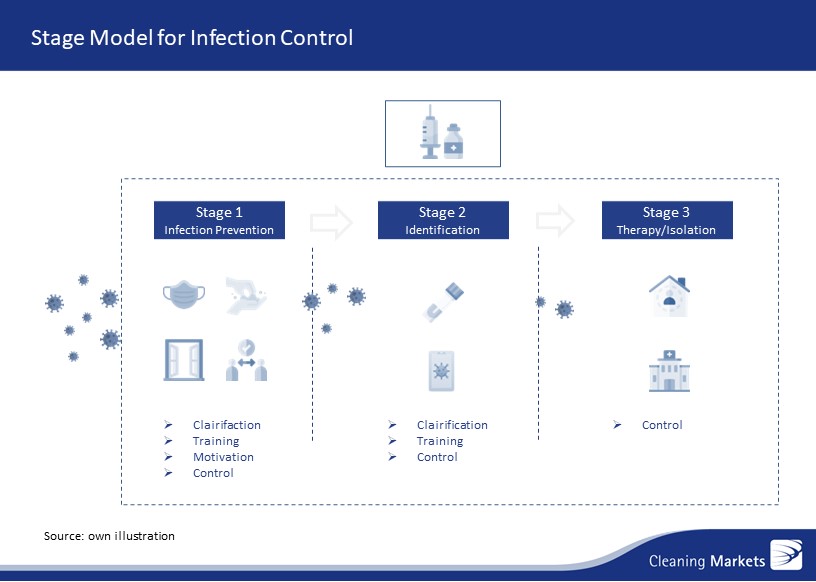
Corona – What’s Next? How the approach to hygiene and infection prevention will change?
Anyone who follows the debates in the media closely will notice that the entire country is longing for normality. This is all too understandable after the last 1.5 years of deprivation. However, it is also time to draw a conclusion and ask:
What have we learned in the last few months and what of it will remain after the pandemic?
This question is not easy to answer. The interdependencies in relation to the measures taken are too complex. For some, the lock-down and the associated restrictions could have been even harsher, while others see their fundamental rights at risk. A final consideration must therefore also include social and economic effects that may not be directly related to the measures taken. But what does this mean for the future and, of course, for further pandemic management in the fourth wave?
First of all, it must be noted that a national effort, as is necessary to contain a pandemic, is hampered by different currents and an uneven knowledge-base in the population. In addition, the latter contributes to the fact that scientifically unsubstantiated theories and misinformation can be spread more easily. This in turn can lead to resistance or a rejection of necessary measures. In Germany, we have seen during the pandemic that systematic and comprehensive education of the population through the communication of relevant information has taken place only inadequately. Although there was constant reporting on the Corona pandemic and its consequences, the discussion of an economic perspective predominated. Examples of this are the daily presentation of incidence values or hospitalization rates. To effectively manage a pandemic, this is a rather inappropriate approach. The following example from the business world is intended to illustrate this point:
If a company wants to reduce the number of accidents at work, publishing the weekly statistics of accidents at work is of limited help. Instead, the behavior of individuals should be changed in the long-term through training and targeted education to prevent accidents.

Fig.1: Education and training as the basis of infection prevention strategies.
We can draw the same learning from the Corona pandemic. Of course, we are primarily discussing the vaccine. This is also the main key to containing the current pandemic. However, a not inconsiderable proportion of the population is still unvaccinated. Vaccination does not provide 100 percent protection, and there are groups of people who cannot be vaccinated. In addition, there are many other viral diseases, besides Covid-19, whose spread can be minimized through targeted infection prevention measures. For future pandemic management, it is also true that normally a vaccine is not immediately available for new viruses. A certain amount of time is needed here, which can be bridged with infection protection and hygiene measures. Fig.1 is intended to illustrate this. Through targeted education and training of the population, it is possible to change behavior in such a way that pathogens spread less quickly. The more people are educated and trained, the more will join in. This also creates social control and a train-the-trainer effect. The latter in particular makes it possible to reach less educated groups. In order for this method to be successful, it is not necessary to reach the entire population, because if the others behave appropriately, even those who refuse to take the measures do not pose a great danger.

Fig.2: Structure and elementary building blocks of a prevention strategy
If we apply this model concretely to a step-by-step plan for pandemic management, its usefulness becomes clear. Fig.2 shows an optimal approach to pandemic containment. If we assume that a novel virus spreads, neither drugs nor vaccines are likely to be available on an ad hoc basis at the outset. Therefore, measures must be taken as quickly as possible to contain the virus and/or to bridge the time until vaccines or drugs are available. The phased plan envisions three barriers here. Stage 1 relies on conventional hygiene and infection control measures. Here, it is important that as many people as possible in the population are educated and have the necessary knowledge in the application of infection control measures. The framework value is specified here by the state, or the companies involved (hygiene concepts on site). Stage 2 deals with the identification of infected persons in whom an infection has been transmitted despite the measures taken in stage 1. This can be done, for example, by testing and/or digital contact tracing. However, it is also true here that without proper education and training, the measures usually do not work optimally. A recent example of this is the inconsistent testing strategy and the issuance of lay tests without accurate application instructions and training. Once infected individuals are identified, they should be isolated, which happens in Stage 3.
The probability of another virus outbreak of global significance is relatively high. Fig. 3 shows examples of virus outbreaks in the last 20 years. Therefore, it would be even more important to derive knowledge from the current situation in order to be better prepared the next time. Learning within a pandemic can also be essential. If the pandemic, like the current Corona pandemic, proceeds in waves, the measures must be adapted accordingly. The long adaptation period has shown that the behavior of the population in such a case cannot be changed ad hoc without corresponding routines and the necessary knowledge and communication.

Fig.3: Virus outbreaks in a globalized world
How is the situation likely to change in Germany?
Currently, it looks like we will probably return to a similar level of hygiene and infection prevention as we had before the pandemic. All communication from politicians and the press is focused on the vaccination campaign. The sustainable creation of routines, the introduction of new hygiene standards or the general optimization of the hygiene infrastructure are not currently the focus of the players involved. The same applies to the topic of infection prevention. Nevertheless, there are learning effects that can be derived from the pandemic. In part of the population, there have been learning effects that may well be sustainable. No major impetus is to be expected from the government in this area. In the wake of the Corona pandemic, however, a number of very interesting private-sector initiatives have been established which are actively working on new hygiene standards. It remains to be seen, however, whether the hesitant attitude on the part of the public sector is not a mistake. During the pandemic, we often observed that the design of appropriate private companies always have a profit motive. This does not always lead to the best solutions, but can also lead to overreactions. During the pandemic, for example, many hotels or restaurants looked more like a hospital, while elsewhere the approach to infection prevention was rather lax.
We need a proper way in Germany. It is not about teaching people excessive hygiene and creating hospital-like conditions. However, the hygiene infrastructure should have a certain standard and the population should be educated and trained with regard to the greatest risks of infection- requiring political and social will.
Text written by Michael Di Figlia